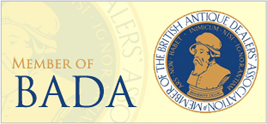| Steppes Hill Farm Antiques Newsletter #13 - July 2012 |
 |
What's on the menu for this month's Newsletter? I hear you ask. Well Menu Holders or Place Card Holders as they are sometimes incorrectly called provides the answer. Menu Holders were generally made in sets of four, although pairs, sets of six, eight and even twelve or eighteen are known. They were designed to hold a printed or painted card displaying the "bill of fare" for the guest's information and placed at intervals along the dining table. They were not originally intended to hold individual guest's name cards, although of course, if you have sufficient numbers of holders they work perfectly well in this respect too.

Click on the image above to view in more detail
Menu Card Holders made of silver and other allied materials were introduced during the Victorian era but reached the zenith of their production during the opulent early years of the early 20th century – "The Golden Age" of the Edwardian period. Society in the Edwardian age was dominated by the King. The legend that surrounds the era is primarily due to the influence of Edward VII. He was a man not only larger than life, but with an insatiable appetite for a wide variety of indulgences from food and wine to women and sport. Hunting Shooting and Fishing were favourite pastimes and these are often reflected in the designs of Menu Holders.
Click on the images above to view in more detail
Conspicuous consumption by the rich was seen as normal and even desirable. That consumption varied from extensive menus, to newly decorated interiors, costly travel abroad, and sartorial art at its most complex, this all epitomised the mood of Edwardian high society.If a hostesses had style they might be lucky enough to entertain the King and Queen, but they would have to be wealthy too, because it was estimated that even a country ball was less expensive to hold than 'a shooting luncheon' for the King. The society family of only moderate means could not afford such affairs and many a 'country' family found itself unable to socialise in the way it wished. The price was literally too high for the family to pay.
The entertainment the King appreciated was costly. He had a hearty appetite, and hearty breakfasts were followed by a hearty lunch, tea, dinner and midnight snack. He enjoyed food of rich flavour and rare quality and seldom sat down to a dinner consisting of less than twelve courses. Nothing was too expensive or too difficult to obtain for his table.
Caviare, truffles, snipe, partridge, oysters, quail, ptarmigan (white grouse), pressed beef, ham, tongue, chicken, galantines, lobster, melons, peaches, nectarines and specially imported jams and biscuits could always be acquired in the hope of pleasing him. His desires set the tone of extravagance associated with the era. A typical society dinner menu for twenty persons cost approximately £60. That was much more than the annual income of a maid.
These extravagant menus would have been displayed to guests in at times equally extravagant silver Menu Holders. I think that they reflect the tastes and desires of the period beautifully.
We have been fortunate to recently acquire a nice selection of Menu Holders from an extensive private collection and they include examples that I have never seen before.

I have been busy this month acquiring new stock and have added approximately 100 new items to the site to coincide with this update. Recent acquisitions include, a rare Lowestoft rectangular Tea Canister, a Victorian Novelty Silver 'Railway Lantern' Sewing Etui / Vinaigrette, a good pair of Royal Crown Derby Vases, a superb Victorian Silver Gilt 'Lake Scene' Book Form Vinaigrette, a First Period Worcester "Gardener" Pattern Tankard, some interesting Wine and Sauce Labels, an extremely fine First Period Worcester Sevres style Teapot, Cover & Stand and some fabulous new additions to the Pencils and Vesta Case Categories.

I do hope that you will find this Newsletter informative and helpful and will allow us send it to you on a regular basis. I would welcome any feedback you may have, both positive and negative.
David W.A. Buck.
Steppes Hill Farm Antiques |
|

 |
 |
|

